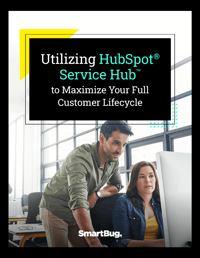
By Ale Melara
The stakes are high for chief customer officers (CCOs) and the organizations they serve. Happy customers are repeat customers—and in today’s era of high customer acquisition costs, businesses can’t afford to lose customers because of a bad experience.
Fortunately, CCOs who use HubSpot are well positioned to retain customers and even turn renewals into upsells. Here are four customer retention strategies to help boost retention and, subsequently, business growth.
1. Analyze Purchase History
Exceptional customer support goes a long way toward improving retention. Effective customer retention strategies tailored to customer support prompt, satisfactory resolution of customers’ problems and concerns, which can be achieved in different ways with different tools.
Leveraging multiple channels—such as live chat, email, and phone support—allows customers to reach you in the way that’s most convenient and comfortable for them. Make sure to arm your support teams with the necessary knowledge and resources to effectively address customer queries and concerns.
How Can You Analyze Purchase History in HubSpot?
Analyzing purchase history in HubSpot provides valuable insights into your customers' behavior, preferences, and purchasing patterns. Here are some tips to help you analyze purchase history effectively:
- Segment your customers: Use HubSpot's segmentation tools to group customers based on their purchase history. For example, you can create segments for first-time buyers, repeat customers, high-value customers, and so on. These groups can help you tailor your marketing efforts and offers to specific customer segments.
- Look at purchase frequency: Analyze how often customers make purchases and identify trends in their buying behavior. This can help you predict future purchases and tailor your marketing strategies accordingly.
- Identify cross-selling opportunities: Analyze which products or services are often purchased together, and use this information to create cross-selling campaigns. For example, if customers who buy product A are likely to also buy product B, you can create targeted campaigns promoting both products to increase sales.
- Monitor customer lifetime value (CLV): CLV is the total revenue a customer is expected to generate over their lifetime. Analyzing purchase history can help you calculate CLV for different customer segments and prioritize your marketing efforts accordingly.
- Track customer churn: Analyze the purchase history of customers who have churned (stopped buying from you) to identify any patterns or trends that may indicate why they left. With this information, you can improve your products, services, or marketing strategies to reduce churn in the future.
- Personalize marketing campaigns: Use purchase history data to personalize your marketing campaigns. For example, you can send targeted offers or recommendations based on a customer's past purchases to increase the likelihood of repeat purchases.
- Monitor product performance: Analyze which products are selling well and which are underperforming. Use this information to adjust your inventory, pricing, or marketing strategies to maximize sales.
2. Look at Customer Browsing Patterns and Engagement Levels
Customer analytics tools such as HubSpot can also provide valuable insights by analyzing browsing patterns and engagement levels. In this way, you can identify areas for improvement throughout the entire customer journey.
For example, if a significant number of customers drop off at a particular stage in the purchasing process, you can identify the pain points that cause this drop-off and make necessary adjustments to improve not just conversation rates but the overall experience.
Here are some tips to help you analyze this data effectively:
- Use HubSpot's tracking tools: HubSpot offers tracking tools that monitor how visitors navigate your website, which pages they visit, and how long they stay on each page. Use these tools to track browsing patterns and identify popular content.
- Segment your audience: HubSpot's segmentation tools can group visitors based on their browsing behavior. For example, you can create segments for visitors who have viewed certain pages or downloaded specific content, which can help you tailor marketing to those visitors.
- Monitor click-through rates: Track the click-through rates of your calls to action (CTAs) and other links to determine which content is most engaging to your audience. Use this information to optimize your CTAs and improve engagement levels.
- Analyze time spent on page: The average time visitors spend on each page tells a story about their levels of interest. Long average times indicate higher engagement levels, whereas shorter times may indicate that the content on those pages is not resonating with your audience.
- Track conversion rates: Monitor the conversion rates of your landing pages and forms. Analyze converted leads’ browsing patterns to identify common pathways to conversion.
- Use heatmaps: Heatmaps visually represent browsing patterns by showing where visitors click, move their mouse, and scroll on your website. Use heatmaps to identify areas of high and low engagement and make adjustments to improve user experience.
- Monitor return visits: Keep track of how often visitors return to your website. A high rate of return visits indicates that your content is engaging and valuable to your audience.
- A/B test different elements: Use A/B testing to experiment with different website elements, such as headlines, images, and CTAs, to see which combinations lead to higher engagement levels
3. Create Custom Fields, Workflows, and Permissions Tailored to Your Specific Processes
Personalization and customization play significant roles in customer retention strategies. CCOs should leverage data and insights to tailor their offerings and communications according to individual customer preferences. Here’s how you can do that with custom fields, workflows, and permissions in HubSpot:
Custom Fields
Custom fields allow you to capture and store specific information about your customers that is relevant to your business. You can better understand your customers' needs, preferences, and behaviors by collecting data that is unique to your business.
This information can then be used to personalize your interactions with customers, such as by sending targeted marketing messages or offering customized products or services. Personalized interactions help strengthen customer relationships and increase loyalty, leading to improved customer retention.
Workflows
Workflows automate various processes based on predefined criteria. By creating workflows tailored to your business's specific processes, you ensure that customers receive personalized and timely communications and experiences.
For example, you can create workflows that send follow-up emails after a customer makes a purchase or that notify your team when a customer is at risk of churning. Automating these processes can help you improve efficiency and consistency in your interactions with customers—which can lead to higher retention rates.
Permissions
Permissions allow you to control access to certain features or data in your HubSpot account. Set permissions tailored to your business's specific needs to ensure that employees access only the information and tools they need to perform their jobs. Permissions also help prevent unauthorized access to sensitive customer data and ensure that employees are using the system correctly. Maintaining data security and integrity is an important way to build trust with your customers and improve customer retention.
4. Leverage Data and Analytics Through Personalized Reporting
If you want to focus on a tailored approach to your customer retention strategies, you need to personalize not just your marketing campaigns but also your data analysis. Here are three HubSpot tools that can help leverage data through personalized reporting:
Personalized Reports
By creating reports that are specific to individual customers or customer segments, you gain deeper insights into their needs, preferences, and behaviors. For example, you can create reports that show a customer's purchase history, support interactions, and feedback. This information can help you anticipate their needs and provide personalized support.
Custom Dashboards
Custom dashboards display key metrics and KPIs that are relevant to your customer support team, thus providing real-time insights that inform decisions and help you develop proactive strategies. Dashboards that show things such as the status of open support tickets, customer satisfaction scores, and response times can help your team prioritize their work and identify areas for improvement, ultimately leading to better customer support and retention.
Custom Data Fields
Custom data fields capture and store relevant information about your customers. Custom fields for things such as product preferences, communication preferences, and support history provide a more personalized support experience; you can use this information to address customers by name, reference previous interactions, and offer tailored solutions to their problems. This level of personalization helps you build stronger relationships with your customers.
With customer retention so important to CCOs, they need powerful, efficient tools to gather vital data. HubSpot's customer analytics tools enable you to take your customer retention strategies and identify trends, patterns, and opportunities for improvement.
Effective use of these tools leads to data-driven decisions that enhance your customer retention strategies, increase renewals, and, ultimately, propel business growth.

About the author
Ale Melara is a Sr. Content Marketing Manager based out of El Salvador, Central America. Ale is our very first LATAM employee. She's worked remotely for the past 5 years and she's had different roles in sales and marketing. In her free time, she works on creating educational videos around digital marketing for her "Inbound Nomad" social accounts where she promotes traveling the world while being a full-time marketer. Read more articles by Ale Melara.








-2.png?width=800&length=800&name=Blog%20header%20image%20(1)-2.png)